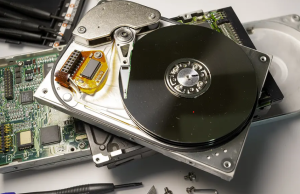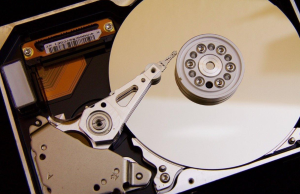Maximizing Hard Drive Lifespan: Important Maintenance Practices
Thing you should keep it mind to increase your hard drive lifespan
1. Keep it Cool:
Maintaining optimal temperatures is crucial for your Hard Drive Lifespan. Excessive heat accelerates wear and tear, diminishing their lifespan. Adequate ventilation and ambient cooling systems are vital to dissipate heat effectively. By preventing overheating, hard drives can operate smoothly, reducing the risk of premature failure and data loss. Strategic placement in well-ventilated areas and regular monitoring of temperature levels help sustain peak performance. Thus, prioritizing a cool environment for hard drives not only ensures their longevity but also safeguards the integrity of stored data, contributing to the reliability and stability of computing systems.
2. Avoid Physical Shocks:
Hard drives, intricate mechanical marvels, are susceptible to damage from physical shocks and vibrations. Handling them delicately, shielding them from drops or jolts, is paramount for longevity. Even minor impacts can disrupt delicate components, potentially leading to data loss or drive failure. Mitigating physical shocks extends the operational of your hard drive lifespan, ensuring reliability and data integrity. Therefore, whether installing, transporting, or simply handling hard drives, a gentle touch and cautious approach safeguard these essential components, preserving their functionality and safeguarding valuable data stored within.

3. Periodically Check SMART Data:
Regularly monitoring the SMART (Self-Monitoring, Analysis, and Reporting Technology) data of hard drives is crucial for preemptively identifying potential issues and ensuring data integrity. SMART attributes provide insights into the health and performance of the drive, including factors like temperature, spin-up time, and error rates. Utilizing software tools to periodically check SMART data allows users to detect early signs of drive degradation or impending failures, enabling timely intervention such as data backup or drive replacement. By proactively assessing SMART data, users can mitigate the risk of unexpected drive failures, preserving critical data and optimizing system reliability for uninterrupted operation.
4. Use Error-Checking Tools:
Regularly utilizing error-checking tools provided by the operating system is essential for maintaining the health and integrity of hard drives. These tools scan the drive for errors, bad sectors, and other potential issues, allowing users to address them before they escalate into significant problems. By identifying and resolving errors promptly, users can prevent data loss and extend the hard drive lifespan. Scheduled error checks, combined with proactive maintenance practices, ensure the drive operates optimally, minimizing the risk of performance degradation and unexpected failures. Incorporating error-checking into routine maintenance routines enhances data reliability and system stability, providing peace of mind for users.
5. Update Firmware:
Regularly updating hard drive firmware is crucial for optimal performance and security. Manufacturers release firmware updates to address bugs, enhance compatibility, and improve stability. By staying current with firmware releases, users can mitigate potential issues and ensure their drives operate reliably. Updating firmware involves downloading the latest version from the manufacturer’s website and following installation instructions. Some drives may support automatic updates through dedicated software utilities. Keeping firmware up to date not only extends the lifespan of the hard drive but also safeguards data integrity, ensuring smooth operation and protection against vulnerabilities.
6. Avoid Overfilling:
Overfilling hard drives can compromise their performance and longevity. Leaving ample free space prevents fragmentation and maintains optimal performance. Strain from excessive data can lead to slower read/write speeds and increased wear on drive components. Managing storage capacity wisely ensures efficient operation and extends the lifespan of hard drives. Regularly assessing storage needs and prioritizing essential files prevents overfilling, preserving both drive health and data integrity. By maintaining a healthy balance between storage capacity and usage, hard drives can function optimally, mitigating the risk of failure and ensuring reliable data storage for the long term.

7. Backup Regularly:
Regular backups are a cornerstone of data management, essential for preserving vital information and safeguarding against potential loss. Scheduled backups mitigate the impact of hardware failures, human error, or malicious attacks, ensuring data remains accessible and intact. Employing reliable backup solutions, such as cloud services or external drives, offers redundancy and peace of mind. By adhering to a consistent backup regimen, the risk of irreparable data loss diminishes, even in the face of unforeseen circumstances. Prioritizing regular backups not only fortifies data security but also fosters resilience, empowering individuals and organizations to navigate challenges with confidence and continuity.
8. Avoid Heavy Disk Activity:
Minimizing heavy disk activity is paramount to preserving the health and longevity of hard drives. Excessive read/write operations strain the mechanical components, accelerating wear and increasing the risk of failure. Distributing tasks over time and prioritizing efficiency reduce the workload on the drive, promoting optimal performance and extending its lifespan. Employing techniques such as batch processing, caching, and resource optimization mitigates the impact of heavy disk usage. By managing disk activity judiciously, users can mitigate the risk of premature failure, ensuring the reliability and longevity of their storage infrastructure while optimizing system performance for sustained productivity.
9. Use Quality Power Supply:
A reliable power supply is fundamental to the stability and longevity of hard drives. Low-quality or unstable power sources can lead to voltage fluctuations or surges, potentially damaging drive components and causing data corruption. Investing in a quality power supply unit (PSU) with robust voltage regulation and surge protection safeguards against such risks, ensuring consistent and clean power delivery to the hard drive. This mitigates the likelihood of drive failures due to power-related issues, prolonging its operational lifespan. Choosing a reputable PSU brand with adequate wattage for system requirements enhances overall system reliability, protecting valuable data and preserving hardware investments.
By following these tips, you can help extend the life of your hard drive and ensure that your data remains safe and accessible for as long as possible.
For more information visit: elmzaango.com
For more information visit: newsburing.com
